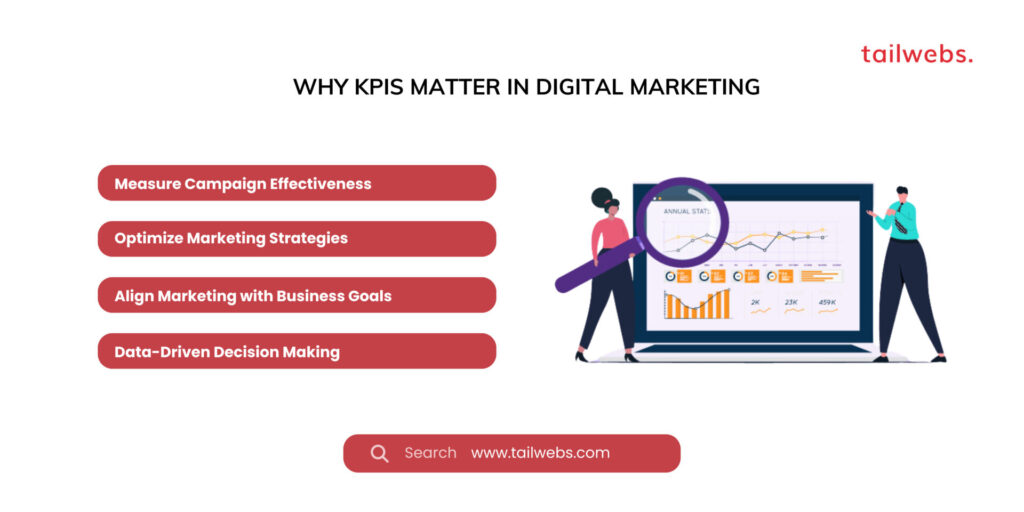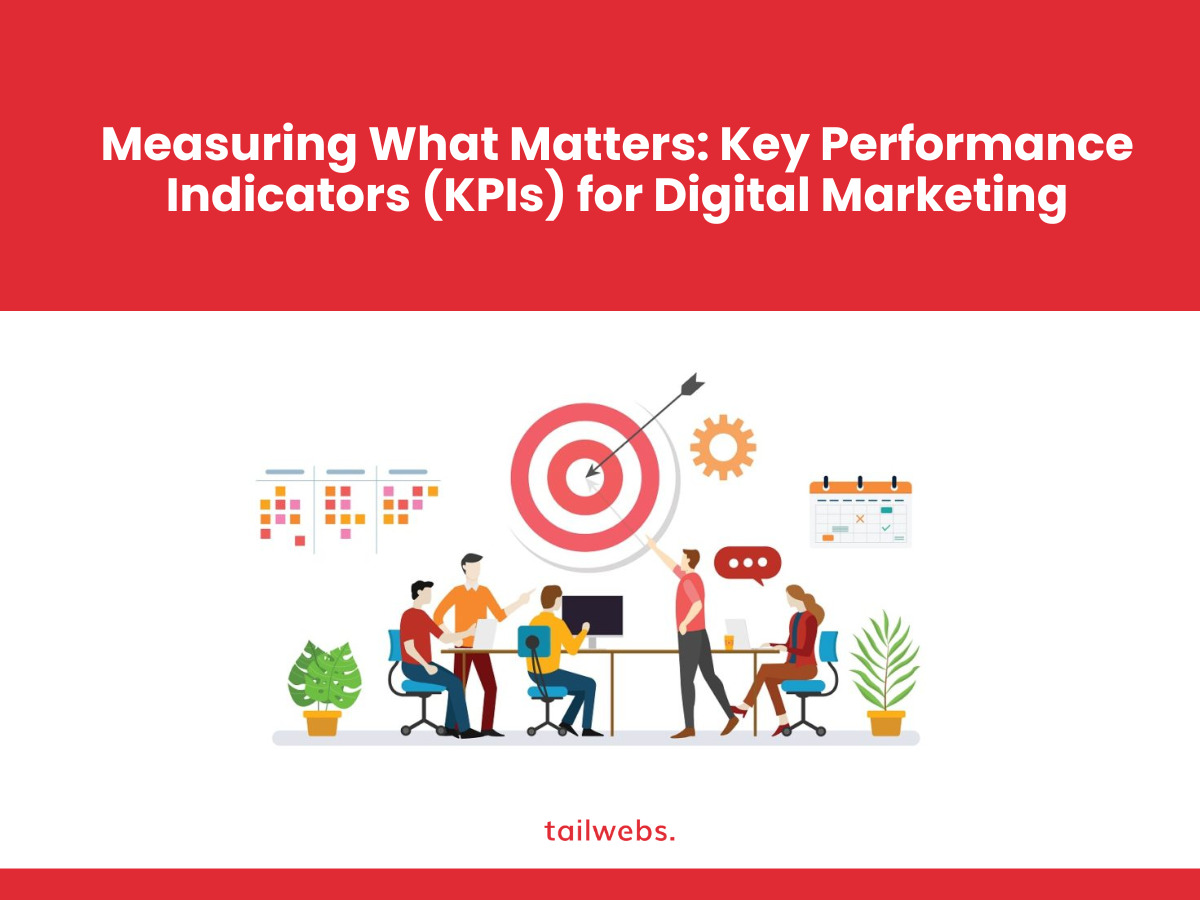In the ever-evolving world of digital marketing, data reigns supreme. But with a vast amount of data at your fingertips, how do you identify what truly matters? The answer lies in Key Performance Indicators (KPIs). KPIs are quantifiable metrics that track the effectiveness of your digital marketing campaigns and strategies.
By focusing on the right KPIs, you gain valuable insights into your audience engagement, campaign performance, and return on investment (ROI). This comprehensive guide explores the importance of KPIs in digital marketing, delves into different categories of KPIs, and provides a framework for selecting the most relevant KPIs for your specific marketing goals.
Why Key Performance Indicators (KPIs) Matter in Digital Marketing
Imagine driving a car blindfolded. Without any gauges or indicators, it’s impossible to know your speed, fuel level, or even where you’re headed. Similarly, digital marketing campaigns without KPIs are like driving blindfolded. KPIs provide the essential metrics that guide your marketing efforts and ensure you’re on the right track to achieve your goals.
Here’s a breakdown of the significance of KPIs in digital marketing:
Measure Campaign Effectiveness:
KPIs allow you to quantify the success of your marketing campaigns. Did your social media campaign generate leads? Did your pay-per-click (PPC) ads drive website traffic? KPIs provide the answers to these crucial questions.
Optimize Marketing Strategies:
By tracking KPIs over time, you can identify areas for improvement and optimize your marketing strategies for better performance. For example, if your website conversion rate is low, you can analyze user behavior data and implement A/B testing to optimize website elements for better conversions.
Align Marketing with Business Goals:
KPIs bridge the gap between marketing activities and overall business objectives. By aligning marketing KPIs with broader business goals like sales growth or brand awareness, you can demonstrate the measurable impact of your marketing efforts on the company’s bottom line.
Data-Driven Decision Making:
KPIs empower data-driven decision making. Instead of relying on gut feelings or anecdotal evidence, you can base your marketing decisions on concrete data and insights derived from KPI tracking.

A Framework for Selecting the Right Key Performance Indicators (KPIs)
With a multitude of KPIs available, choosing the right ones can be overwhelming. Here’s a framework to guide your KPI selection process:
Define Your Marketing Goals:
The first step is to clearly define your overall marketing goals. Are you aiming to increase brand awareness, generate leads, drive website traffic, or boost sales? Your goals will determine the most relevant KPIs to track.
Identify Customer Journey Stages:
Consider the different stages of your customer journey. Are you targeting users at the top of the funnel (awareness), the middle of the funnel (consideration), or the bottom of the funnel (decision)? KPIs will differ depending on the customer journey stage you’re focusing on.
Select Relevant KPIs:
Based on your marketing goals and customer journey stages, choose a set of KPIs that directly measure your progress towards those goals. Don’t get bogged down by tracking too many KPIs; focus on a handful of high-impact metrics that truly matter.
Essential Categories of KPIs for Digital Marketing
Here’s an overview of essential KPI categories for digital marketing, along with specific examples for each:
Website Traffic KPIs:
Website Sessions:
The total number of times users visit your website within a specific timeframe.
Unique Visitors:
The number of individual users who visit your website within a timeframe.
Page Views:
The total number of pages viewed on your website.
Bounce Rate:
The percentage of visitors who leave your website after viewing only one page. A high bounce rate indicates a potential issue with website content or user experience.
Engagement KPIs:
Average Time on Page:
The average amount of time users spend on a specific page on your website.
Social Media Engagement:
The number of likes, comments, shares, and mentions your brand receives on social media platforms.
Email Open Rate:
The percentage of email subscribers who open your email marketing messages.
Click-Through Rate (CTR):
The percentage of users who click on a specific link within your content, such as a call to action (CTA) button.
Lead Generation KPIs:
Cost per Lead (CPL):
The average amount you spend to acquire a new lead through marketing activities.
Lead Conversion Rate:
The percentage of website visitors who convert into leads by submitting a form or providing contact information.
Marketing Qualified Leads (MQLs):
MQLs are leads who have demonstrated a stronger interest in your product or service and are considered sales-ready. Track the number of MQLs generated through your marketing campaigns to assess their effectiveness in attracting high-quality leads.
Sales Qualified Leads (SQLs):
SQLs are leads who are deemed highly likely to convert into paying customers. The criteria for qualifying an MQL as an SQL can vary depending on your business model. Track the number of SQLs generated by your marketing efforts to measure their contribution to the sales pipeline.
Lead Velocity:
Lead velocity refers to the rate at which you generate qualified leads. This metric is calculated by dividing the number of new qualified leads by the timeframe (e.g., leads generated per month). Monitoring lead velocity helps you assess the momentum of your lead generation efforts.
Sales KPIs
Sales KPIs track the effectiveness of your marketing efforts in driving revenue and achieving your sales goals. Here are some essential sales KPIs:
Conversion Rate:
The conversion rate represents the percentage of website visitors or leads who convert into paying customers. Track conversion rates for different marketing channels and campaigns to identify the most effective strategies for driving sales.
Customer Acquisition Cost (CAC):
CAC is the average cost associated with acquiring a new customer. This metric factors in all marketing and sales expenses incurred to acquire a customer. Tracking CAC helps you assess the efficiency of your customer acquisition efforts.
Customer Lifetime Value (CLTV):
CLTV represents the total revenue a customer is expected to generate for your business throughout their relationship with your brand. Understanding CLTV helps you evaluate the long-term profitability of your customer acquisition efforts.
Brand Awareness KPIs
Brand awareness KPIs measure how well your target audience recognizes and remembers your brand. Here are some key brand awareness KPIs:
Brand Mentions:
Track the number of times your brand is mentioned online, including social media mentions, news articles, and online reviews. This provides insights into your brand visibility and the overall sentiment surrounding your brand online.
Social Media Followers:
Monitor the growth of your social media follower base across different platforms. This indicates your brand’s reach and audience engagement on social media.
Website Traffic Sources:
Analyze where your website traffic originates from. An increase in organic traffic (traffic from search engines) can indicate improved brand awareness and discoverability.
Brand Search Volume:
Track the search volume for your brand name and related keywords using tools like Google Trends. An increase in search volume suggests growing brand awareness and interest in your offerings.

Additional Considerations for Effective KPI Tracking and Reporting
Here are some additional tips to ensure your KPI tracking and reporting are effective:
Set SMART Goals:
Ensure your marketing goals are SMART (Specific, Measurable, Achievable, Relevant, and Time-bound). SMART goals provide a clear framework for selecting relevant KPIs to track progress.
Establish Baselines:
Before implementing new marketing initiatives, establish baseline data for your chosen KPIs. This allows you to measure the impact of your efforts and track progress over time.
Regular Reporting:
Schedule regular reporting cycles (e.g., weekly, monthly) to track KPI performance. Visualize your data using charts and graphs to identify trends and make data-driven decisions.
Align KPIs Across Teams:
Ensure marketing and sales teams are aligned on the KPIs being tracked. This fosters collaboration and ensures everyone is working towards the same goals.
Conclusion: Leveraging KPIs for Marketing Success
By identifying and tracking the right KPIs, you can gain valuable insights into the effectiveness of your digital marketing efforts. Use these insights to optimize your campaigns, maximize ROI, and achieve your overarching marketing and business goals. Remember, KPIs are not static; they should evolve alongside your marketing strategies and business objectives. Regularly evaluate your KPI selection and adapt your tracking approach to ensure you’re measuring what truly matters for your ongoing digital marketing success.





